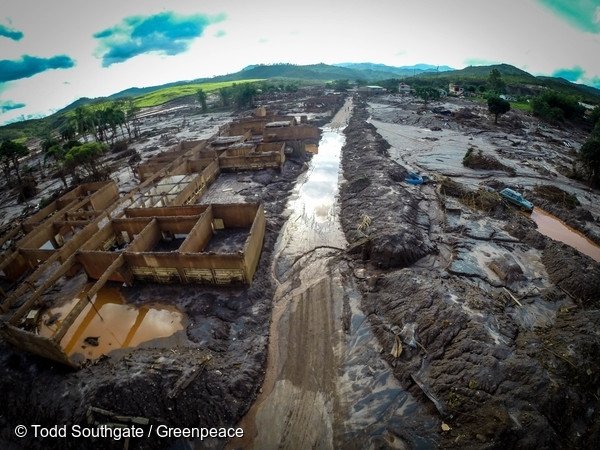Six months later: communities are still suffering from one of Brazil’s worst environmental disasters

Six months have passed since one of the worst environmental tragedies in Brazil’s history: the Samarco dam collapse. On 5 November, 2015, Samarco’s mining waste dam gave way, releasing a torrent of contaminated mud that killed 19 people and left a 600 km trail of destruction as mining waste flowed down the Doce River to the Atlantic Ocean. Families, animals, houses, entire cities and the Doce River were devastated.
Today, Greenpeace Brazil joins #UmMinutoDeSirene, a symbolic protest on the fifth day of each month in Mariana, the town where the mining dam collapsed. Protesters sound an alarm siren – one that never rang on the day of the accident to alert the local population – so that no one forgets what took place there. Samarco – a joint venture between Brazilian mining company Vale and Anglo-Australian BHP Billiton – is to blame for the silence at the time of the incident. There was no plan in place to warn people for this type of emergency.
The sound is also a reminder that the Doce River area has been suffering six months of social and economic consequences from the Samarco dam collapse. Though half a year has passed, very little has been done to compensate local communities and individuals for their losses.
We must continue to make noise to remind the world that the consequences of this deadly accident are still impacting thousands of people.
Greenpeace Brazil has launched a website (here in Portuguese) to let all of us sound the alarm for affected communities, the buried cities and for the Doce River – which no longer holds life.
Help make sure this deadly accident and the people is continues to impact are not forgotten. Please share this story.
Vagner João de Carvalho, a citizen of Mariana, and his daughter came to survey the damage in the region one month after the disaster.
Damage in the district of Bento Rodrigues, in Mariana, Minas Gerais state, one month after the Samarco mining dam collapse.
View of the district of Paracatuzinho, 100km from Mariana, Minas Gerais state, hit by a mineral waste flood after the Samarco mining dam collapse.
A view of the district of Bento Rodrigues, in Mariana, Minas Gerais state, one month after the Samarco mining dam collapse.
The Burun Krenak Indigenous People protest after the environmental disaster caused by the collapse of two dams from Samarco mining company.
Alan Azevedo is a communications analyst at Greenpeace Brazil.
Source: Green peace





 sending...
sending...